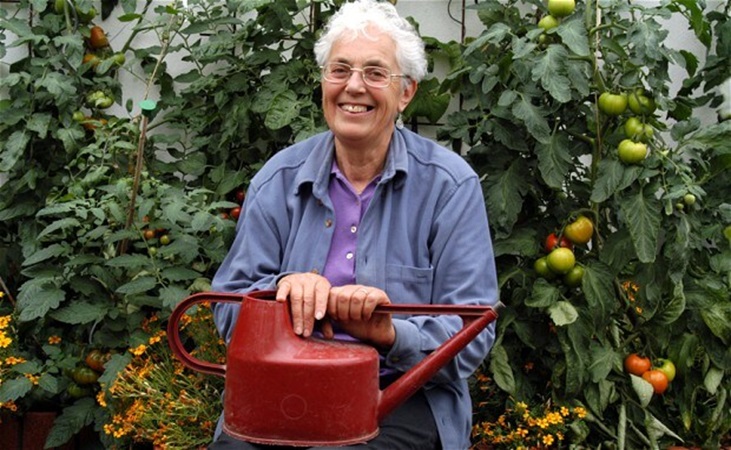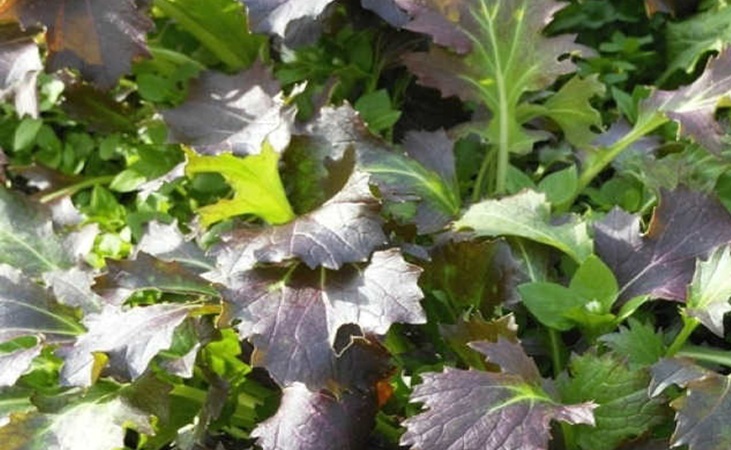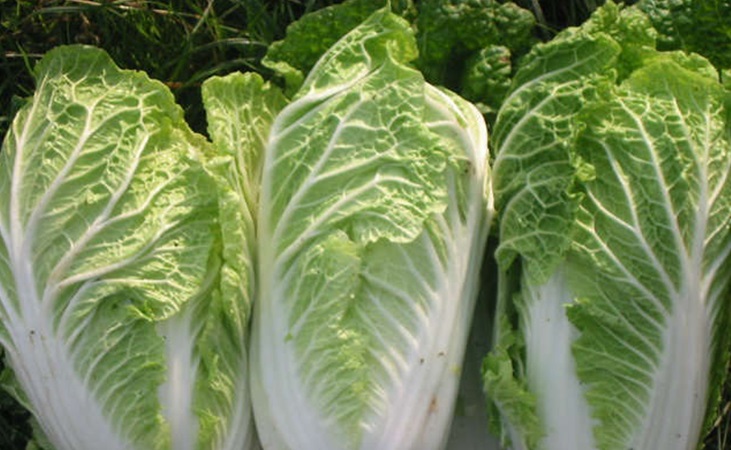Oriental Vegetables for Autumn Sowing
When we move towards the end of July and into early August it can be easy to think the season for sowing new crops is over. To be fair that's true for most things, with the garden now in the 'maturing and harvesting' part of the cycle rather than those first stages of fragile seedlings and tender new growth.
There are a number of exceptions, however, including a range of leafy vegetables known collectively as 'Asian Greens'. Asian greens are quick-growing, vigorous and succulent, and they open up a whole new range of possibilities for the tail end of the growing year.
Joy Larkcom is largely responsible for the growing popularity of these crops in Ireland and the UK. Her interest stems from her initial trips to China as a child, followed by a ground breaking study trip in 1985 and further trips to Hong Kong, Taiwan and Japan.
Joy also spent time in North America and Canada learning what Asian communities in the West were growing, all the while piecing together this enormous jigsaw of largely unknown vegetables.

If Asian greens are a subject you are interested in (and you should be, because the choice of fresh varieties to add to your garden is vast!) then Joy's book ' Oriental Vegetables' is essential.
You will be taken through one of the most detailed lists of potential crops you will find anywhere, followed by a section on expert growing advice (Joy is of course the author of what is still arguably the best vegetable growing book, 'Grow Your Own Vegetables'), before closing with a recipe and preparation section to explain just what you can do with your newly discovered ingredients.
What's so great about this book is that Joy is the undisputed expert: it's all first hand personal experience and proper, dependable knowledge. Here's what Alys Fowler says about her in the Guardian: " No one else manages to marry a relaxed, joyful approach to gardening with science and trialling. You can truly trust what she says."
Thanks to author and journalist Jane Powers ( An Irish Nature Year) for the photo of Joy. Jane also writes a blog One Bean Row (shortlisted for the blog awards) which is always well worth a read.
So there you are, anyway, back to the point:

Why are Asian Greens Suited to Autumn Growing?
Obviously our journey from the longest day in midsummer to the shortest day in midwinter features shorter days, colder temperatures and lower light levels.
Growing in the latter part of the year means we have some limited options:
- fast maturing crops that will be ready to harvest before it gets too cold for further growth
- something that can survive and still be (marginally) productive over winter or
- something that can lie dormant over winter to provide crops in early Spring.

Turnip Tokyo Cross - F1
View ProductAs you will see in Joy's book, Oriental vegetables offer a wide variety of possibilities, but it's the Radishes, Turnips and Salad Greens we're interested in here. They tick both the 'fast growing' and 'cold tolerant' boxes, and will produce crops before temperatures drop in late Autumn. When planted undercover they can even provide welcome fresh greens in the middle of winter, when freshly picked leaves are a real treat.
Most Asian greens are members of the Brassica or cabbage family, and they offer a range of flavours; from crisp and refreshing Pak Choi ('Joy Choi' is the best) to more spicy leaves like Rocket, to very hot and mustardy varieties like 'Green in the Snow' and 'Osaka'.

Pak Choi 'Joi Choi F1' - Asian Salad
View ProductMost of these are easy to grow and are perfect candidates for 'Cut and Come Again' cropping, where new growth replaces harvested greens.
Indeed, Asian salad crops are far better suited to late season growing, as many of them are likely to run to seed if sown earlier in the year with longer days and warmer temperatures. Autumn is the perfect season for them!

High Yields of 'Cut and Come Again' crops make them perfect for container growing.
'Cut and Come Again' is the practice of sowing seed quite thickly and harvesting a mat of salad by trimming with a scissors. Seedlings are cut when they are about 5 - 10cm high, and will re-grow and be ready to harvest again in about a week.
Usually you can get 3 cuts from each sowing, which is a very productive use of space, and ideal for small gardens or urban container growing.
The harvests of seedlings (these are known as baby leaves in shop-bought salad bags) are very tasty and highly nutritious, and unlike their supermarket cousins they won't be sprayed with chlorine to keep them fresh in the bag.
To me this is where value well and truly comes in, as shop-bought baby leaves are expensive (half of which inevitably gets thrown out). Your own homegrown versions on the other hand will cost less than a fiver for seeds and will give you numerous fresh harvests.
Which Asian Green Varieties to Grow?
Again, the possibilities are almost endless; but luckily (aren't we great?) we have a nicely considered range of seeds available to order at Quickcrop. We've included some of the best varieties for baby leaf production, as well as some interesting crops like miniature white turnip 'Tokyo Cross' and fantastic radish varieties like 'Watermelon' and 'China Rose'.
Here follows a list of my favourites; the full range of Oriental Brassica Salads are available on our website.

Mustard Red and Green Frills
We'll start with my favourite. Red and green frills taste pretty much the same, with the difference being either a vibrant bright green leaf or a deep red. The shape of the leaf is a bit like wild locket, with delicate, deeply dissected lobes.
Flavour is peppery without being overpowering, with a fresh aftertaste from its wasabi green stems. Both Red and Green frills have been specially bred for baby leaf 'cut and come again' production.

Mustard 'Red Frills' - Asian Salad
View Product
Mizuna (Red and Green Varieties)
Mizuna has a similar shape leaf to the mustards, but with a much milder flavour and tender and juicy stems. Plants are naturally healthy and vigorous, and they re-grow very quickly after cutting so are ideal for C&CA.
Mizuna is also less likely to bolt, and is probably the most reliable Asian green in this respect. Good tolerance to cold means Mizuna grown undercover can crop right through a mild Winter, and will definitely be the first to produce in early Spring.

Pak Choi
Pak Choi can be used in a number of different stages. We are more used to the mature stage - with thick and juicy white stems - but you may have also noticed the seedling or 'chicken feather' stage hiding in salads.
Joy Larkcom says the Pak Choi seedling stage is by far her favourite for salads, because of crisp, succulent leaves and a fresh healthy-looking colour. Plants can also be grown to an intermediate 'Little Cabbage' or baby pak choi stage, which - while retaining the mild fresh flavour of seedling leaves - also leads to swollen and juicy leaf stalks.

Asian Salad - Surprise Mix
View Product
Green In The Snow
'Green In The Snow' is spicier than most of the other oriental leaves, with the heat increasing as the leaves get bigger - especially when the plant is beginning to run to seed. Immature leaves are best with a pleasant kick; try using larger leaves in stir fries where cooking will temper the heat.
'Green in the Snow' is very hardy, and as its name suggests it will withstand cold temperatures. Best sown in late summer to avoid bolting, this vigorous and reliable plant will give pep to your plate up to late Autumn, with plants grown under cover continuing to produce until the following spring.

Chinese Cabbage
Chinese cabbage comes in a number of guises including cylindrical, barrel and loose-headed types. 'Yuki F1' in the photo above is a barrel-headed type which produces heads of fresh and juicy leaves 50-70 days after sowing.
Remember that the quick and vigorous growth will require a fertile plot: a handful of Seafeed Seaweed and Poultry manure pellets mixed around the planting hole will be beneficial if the soil is tired from a previous crop.

4kg Seafeed Natural Seaweed Extract & Poultry Manure Fertilizer
View ProductChinese Cabbage can be used fresh, where its crispy texture makes it a more flavoursome replacement for iceberg lettuce. Cooking requires restraint, as overdoing it will ruin the flavour. Lightly steam or stir fry and never boil (as you would a European cabbage).

Radish 'Watermelon' Radish 'Watermelon' Seeds
Also know as 'Red Meat' or 'Beauty Heart' radishes watermelon have a rather boring looking exterior with white flesh and a green top, the surprise comes on the inside which is bright magenta.
Flavour is sweet and mild when harvested young at about 4 or 5 inches in diameter, leave them too long and they will get woody.
Beauty heart radishes are traditionally carved in China to produce decorative flowers using the contrast between the green tinged white skin and pink centre to create incredibly intricate works of art. I thought the following was particularly evocative from Joy Larckom's book on encountering a radish carving lady chef in Beijing, I hope she doesn't mind me using it:
"She created dahlias, peonies, water lilies, chrysanthemums and, best of all, an exquisite butterfly, its red-and-white-tipped wings delicately hinged slices of radish. We had to leave to catch a train before she had time to make us crickets and dragonflies, but she put the butterflies into a plastic bag filled with water to keep them fresh, and we took them away like goldfish won at a fair".

Radish 'China Rose' Radish 'China Rose' Seeds
'China Rose' is a peppery late season radish which is cold tolerant and can be left in the ground over Winter (if you have a heavy soil you might be better to lift them and store in boxes of moist sand).
The skins are spicier than the flesh so milder when peeled if you want to eat them raw, otherwise use them as you would carrots or parsnips underneath a roast.
'China Rose' can also be left in the ground over winter (better under cover) and allowed to flower and produce seed pods in the Spring. The seed pods can be eaten in stir fries, used in salads or pickled. You can also try Munchen Bier which is a dual purpose German radish grown for either seed pods or its long white tap root eaten as a beer drinkers snack.

Turnip 'Tokyo Cross' Turnip 'Tokyo Cross' Seeds
Tokyo Cross is a Japanese hybrid turnip with a snowy white skin, they and are generally sweeter than the larger European varieties.
Tokyo Cross mini turnips are best picked when small (1-2 inches in diameter) when they are sweet, tender and delicious raw. Try then with a little salt and dressing and you'll be running for the seed packet to sow more.
'Tokyo Cross' is very fast growing and can be pulled 30 days after sowing if conditions are good. Good to sow in August outside but can also sown in late Autumn if grown under cover.

Where to Grow Oriental Salads I'm aware this is turning into a hit parade of our products (no surprise there say regular readers) but if you don't have a Poly Tunnel or Greenhouse then this is just about the perfect solution for you.
If you're going to pop outside to pick some fresh greens when Wimbledon is a distant memory and a trip to the beach requires more than 3 layers of clothing then you might as well make it easy on yourself. Put your crops beside the back door, get them up off the ground at an easy height and put a custom made cover over them. In short get yourself a ' Vegtrug'.

Vegtrugs are available with custom made covers in fleece, micromesh and poly. The 1m Vegtrug and 1.8m Vegtrug are both available with additional steel frames which fit a choice of interchangeable covers to protect your crops. A 'Vegtrug' raised vegetable planter with a poly cover will give you a broad variety of Autumn Winter crops well past the date you'd normally expect to picking fresh produce. What's more, because the planter is raised off the ground the compost will warm quicker next Spring allowing you a head start on everyone else.
Many of the Orientals listed above can be planted outside at this time of year (early August) and still give you a very worthwhile harvest, you just need to get on with it. Don't forget many of these crops are well suited to container growing so you may have more options than you think. Try some salads and radishes in pots, with a good potting mixture you will be surprised how quickly they will grow.

How to Grow Oriental Salads Like most vegetables I would recommend sowing in modules for all the usual reasons, number one being they are protected in the early stages of growth. It is important not to let the plants get stressed (under or over watering, becoming pot bound) as they are quick to go to seed if they're feeling uncomfortable. If you are sowing dense mats of Cut and Come again crops please see section below.
I find 84 cell modules are best and sow 4 seeds per module for leaf crops like Mizuna, Red and Green Frills, Rocket and other leaf salad crops. Sow 2 seeds per module for larger plants like Pak Choi or Chinese cabbage thinning out the weaker seedling if more than one germinates. In general the oriental brassicas (all of the above are members of the brassica family so take this into account in your crop rotation) germinate very reliably and should be up in 4 or 5 days at a temperature of 18-20˚C.
Plant out module grown salad seedlings at 25cm between rows and 20cm between each module of 4 seedlings. For larger plants like mature Pak Choi or Chinese Cabbage allow 45cm each way.

Sowing for Cut and Come Again crops. As we've said above salad seed for 'Cut and Come Again' harvests can be sown thickly in situ either directly into prepared garden soil or in pots. Broadcast sow seeds at approx 15g per square meter with the first harvest ready to be cut when the seedlings are 1-3 inches high.
It is important to cut the seedlings above the first tiny set of leaves (cotyledons) or the plants won't regrow. Unfortunately I don't have a better photo but the cotyledons are the rounded leaves in the picture opposite, the first true leaves are growing from the centre of the plant. At harvest time the true leaves will be much bigger, just don't cut below the first leaf junction shown in the photo.

C&CA plantings are very intensive so keep a close eye on watering and make sure your planting mix is well fed. I don't want to keep banging on about the same thing but our old friend Seamungus composted seaweed and poultry manure is an ideal feed as it has plenty of nitrogen for lush, leafy growth and is slow release, usually feeding for the lifetime of the crops.
Apart from being very productive C&CA also has two other distinct advantages, it tends to delay bolting and can also help plants survive a heavy frost. Harvested plants without large leaf areas will sit in a dormant state at low temperatures only to kick back into growth when it warms up again.
Crop Care Keep plants well watered and ensure your soil or compost is well fed to begin with. Flea beetle can be a big problem with earlier sowings, as can bolting but the beauty of sowing late in the season (from early August) is that they will be far less of a problem.
In general all the Oriental Brassicas are naturally vigourous, healthy and easy to grow and shouldn't pose a problem even for the most inexperienced grower.
Need any More Help? I'm not being smart but buy Joy Larckom's book, it's all in there right from the horses mouth. Joy is the undisputed expert from a lifetime of research and trials, anyone else (including me) is just scratching the surface.
If I can be of any help with products, seeds or advice please feel free to contact me using our contact page, I am always happy to help.
Clean off your seedling trays, trowel and dibber and get sowing again for a whole new mini season of exciting new plants.
